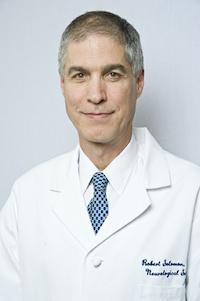Dr. Sean Lavine’s Coiling Lets a Ballerina Keep on Spinning
On October 18, 2011, Ellen “Ferne” Glemby was in a car accident that changed her life. “A kid cut in front of me,” says Ferne. “My car was totaled, and he walked away.”
Ferne left the accident with a herniated disc in her back, weakness on the right side of her body and a head injury that had likely made a change in her brain that would nearly kill her five months later.
A young 60, Ferne had been in ballet class two days before the accident. She had danced professionally for 20 years at places like Lincoln Center and Radio City Music Hall.
Ferne says the endurance and discipline from her years as a dancer are what carried her through the pain and rehabilitation she had to go through after her accident.
Five months into her therapy, she was stronger, but she began to get frequent, debilitating headaches. She was also having some difficulty hearing out of her left ear and figured there was something wrong with her sinuses.
She went to an ENT (ear, nose and throat) doctor, who ordered an MRI to take a closer look. What he found surprised everyone: Ferne had a two-centimeter mass on the left side of her brain. The doctor told her she needed to see a neurosurgeon because the mass had the appearance of an aneurysm.
An aneurysm occurs when an area within the wall of a blood vessel weakens and bulges or balloons outward. The aneurysm fills with blood and can put pressure on nearby structures within the brain. It is also at risk of bursting and causing a deadly brain bleed.
Ferne was shocked. “I started doing research on the best medical team and hospital to choose,” she says. She chose Columbia University Medical Center/NewYork-Presbyterian Hospital. They set up an appointment with Dr. Robert Solomon, head of Columbia’s Department of Neurosurgery, right away.
Ferne met with Dr. Solomon, and after reviewing her scans he confirmed that the mass in her brain was likely an aneurysm, but he needed a more detailed picture. He sent her to see Dr. Sean Lavine, a neurosurgeon from Columbia’s Endovascular Center, to get a diagnostic angiogram.
Dr. Lavine specializes in endovascular neurosurgery, employing minimally invasive techniques to both diagnose and treat neurovascular diseases, like aneurysms. Using tiny instruments, powerful imaging technology and sophisticated computer integration, Dr. Lavine can investigate and treat areas deep in the brain by traveling through a patient’s blood vessels.
Whether an aneurysm is best treated using endovascular techniques or open surgical methods, diagnosis and procedure planning both begin with an angiogram like the one performed on Ferne.
From the angiogram, Dr. Lavine confirmed that Ferne had a near-giant aneurysm measuring 20mm. He also says, “Given the unusual location of the aneurysm and the patient’s history of a severe motor vehicle accident, I theorized that this was possibly related to the head trauma.
It is impossible to determine whether the accident caused the aneurysm or if it was a preexisting condition, however, the location, its large size and the symptoms following the accident lead one to believe this is a possible causative factor.” Because of the aneurysm’s large size and high risk of catastrophic rupture, Dr. Lavine decided that Ferne needed surgery right away.
The surgical treatment of unruptured aneurysms falls into two main types, both with the aim of cutting off the blood flow to the aneurysm:
The first is an open-brain procedure called “clipping,” in which a tiny clip is placed on the outside of the blood vessel at the base of the aneurysm. The second is an endovascular procedure called “coiling,” in which tiny coils are placed inside the aneurysm via an artery that feeds into it in the patient’s leg. The coils prevent the aneurysm from rupturing.
In Ferne’s case, Dr. Lavine conferred with Dr. Solomon (who specializes in open-surgical techniques like clipping), and they decided that clipping was not feasible due to the shape of her aneurysm—it had no distinct base to place a clip. They decided that coiling was the best option for her.
“Dr. Solomon and Dr. Lavine both came into the recovery area to speak with me about the results of the angiogram,” says Ferne. “Dr. Lavine was going to perform the surgery, and he told me that in the approximately 5,000 procedures he has performed, this was only the second aneurysm he had seen like mine. Most aneurysms are like a bubble on the artery, while my aneurysm completely surrounded the entire artery.”
Soon thereafter, Dr. Lavine performed an aneurysm coiling procedure on Ferne at Columbia University Medical Center/NewYork-Presbyterian Hospital. The surgery was successful. The coils Dr. Lavine inserted had filled the aneurysm, and she was out of danger.
Ferne could not have been more pleased with Dr. Lavine, Dr. Solomon, the technicians and the nurses who were involved in her care.
“The team that brought me through, from preparation to recovery, was simply amazing,” says Ferne. “They truly cared, they were very professional, everyone had their role and did it with total confidence and empathy. I felt safe and secure in their hands.
“Dr. Lavine and the incredible team at Columbia Presbyterian GAVE ME MY LIFE BACK! It is now my responsibility to make the most of the life they gave me.”

